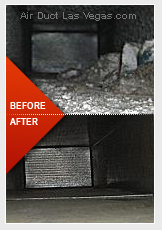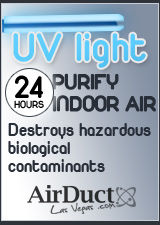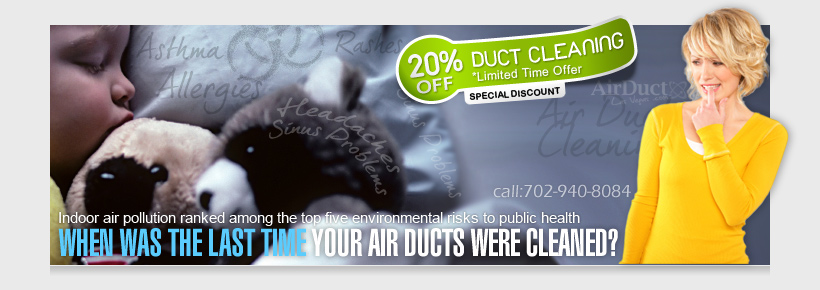Air Duct Cleaning
 Occasional air duct cleaning improve indoor air quality. Have you ever stopped to consider the factors that affect the quality of the air that you breathe when you are inside? More often than not, this air is delivered via the air ducts connected to your heating, ventilation and air conditioning system. Ducts can, over time, become polluted. Consequently, a neglected duct can expel a variety of contaminates into your home. Duct cleaning can remedy this problem
Occasional air duct cleaning improve indoor air quality. Have you ever stopped to consider the factors that affect the quality of the air that you breathe when you are inside? More often than not, this air is delivered via the air ducts connected to your heating, ventilation and air conditioning system. Ducts can, over time, become polluted. Consequently, a neglected duct can expel a variety of contaminates into your home. Duct cleaning can remedy this problem
Air ducts should be cleaned every three to five years, depending on factors such as recent remodeling or construction and the presence of pets, children or elderly in the household. In these cases, it is better to take a conservative approach and opt for shorter spans between cleaning sessions. In addition, poorly functioning HVAC systems may indicate that duct cleaning is in order.
Duct cleaning is an integral part of HVAC maintenance. It has been shown that 90% of all furnace and air conditioning malfunctions can be related to dirt and dust contamination. If the ductwork is dirty, your HVAC system will have impaired functionality. It will have to work longer and harder to provide the required heating/cooling, thus directly impacting the cost of heating/cooling your residence or business.
Cleaning Process
The air duct cleaning process requires expert knowledge and highly specialized. These are the basic steps required:
- Cover registers.
- Create an access hole for duct-cleaning vacuum hose.
- Use industrial strength suction power to vacuum loose dirt found in main duct.
- Force compressed air (200 psi) through each register to channel dirt and debris towards the main duct and vacuum hose.
- Snake cleaning coils throughout the ductwork to clean entire system
- 360 degree high-velocity cleaning heads
- Stubborn contaminants are dislodged and pushed towards vacuum
- Brush and whip ducts to ensure that all debris is removed.
- Repeat process on return ductwork.
- Air-wash blower, blower compartment and air conditioning coil.
Two popular post-cleaning treatments are duct deodorizing and duct sanitizing. Duct deodorizing helps abate typical indoor odors such as pet odors and cigarette or cigar smoke, and organic odors such as mold and mildew, as well. Environmentally safe, and approved for use in practically all ductwork types (e.g., businesses, homes and factories), air duct deodorizing deals with unpleasant smells, rather than merely masking them with masking agents or perfumes.
Once an air duct system has been infiltrated by bacteria, mites, fungus and other organisms that favor the environment found in ductwork, cleaning may not be enough to keep them from coming back. If these organisms continue to breed and grow, they can pose a serious health risk - especially to those suffering from allergies, asthma or other respiratory issues. Applying our EPA-approved biocide/germicide fog is unique in that it provides effective sanitizing without polluting your breathing space with lingering active chemical residues.
Filtration
Electrostatic Filters
It may be surprising to learn that indoor air pollution is one of the top environmental public health risks, as identified by the EPA, which claims that indoor air quality can be significantly more polluted than outdoor air.
One way to deal with indoor air pollution is to use an Electrostatic Air Filter, which uses static electricity to clean the air. This reasonably priced answer to indoor air pollution cleans they air when air flows through a maze of static prone fibers and an electrostatic charge is naturally created. The charge attracts airborne particles which, in turn, are held by the static charge until they are washed away. In addition to enjoying cleaner indoor air quality and a reduction of pollutants such as dust and pollen, some users report that air filters also impact housecleaning! Less dust in the air means less dust on household surfaces, as well.
Mold and bacterial growth is nonexistent, thanks to a special anti-microbial material (EPA registered) which inhibits any such growth on the filter's surface.
Maintenance
Properly maintained Electrostatic Air Filters never need replace and will continue to function well almost indefinitely. While most filters have a high capacity for holding, they should be cleaned every four to six weeks. Improper cleaning and maintenance, however, is sure to have a negative impact on the filter's ability to clean the air. Neglect, which inevitably leads to dirt buildup, can have a snowball effect: deficient air flow resistance will harm other components of the system.
UV Lamps
Ultra Violet Sanitizer
Ultra Violet Sanitizers may be found in the heating or air conditioning system main supplies or air ducts. This type of sanitizer, nicknamed UV Home Air Sanitizer, provides air purification 24/7 by giving off powerful, sterilizing UV light. Air passing through this system is purified and microorganisms typically found in HVAC systems are wiped out. The removal of indoor pollutants is an important preventative step in safeguarding your family's health. Once a UV Air Sanitizer cleanses the environment, asthma and allergy sufferers, as well as those with respiratory sensitivities, will be able to breathe more easily and stay healthier.
As the HVAC system recirculates air at a rate of over fifty times a day, the air is continually exposed to UV light. This continual exposure has been found to improve indoor air quality by reducing the amount of pollutants found in the indoor environment. With this filtration system, more is definitely better - each time air circulates through the system, the disinfection rate goes up.
With a UV Air Sanitizer installed in the HVAC system, household odors are reduced, as are germs and airborne viruses. In addition, the HVAC system will function more efficiently, as drain pans stay free from slime and bacterial growth, such as mold and fungus, is stopped.
Call Air Duct Cleaning Las Vegas at 702-940-8084 to learn more about our HVAC service







 Occasional
Occasional